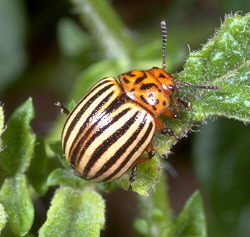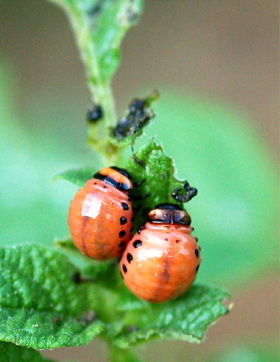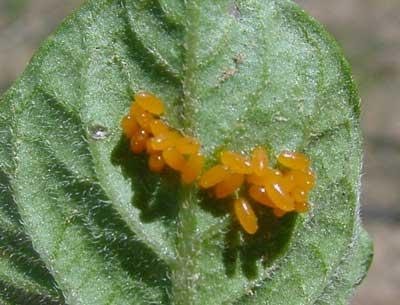Colorado Potato Beetles
go.ncsu.edu/readext?810023
en Español / em Português
El inglés es el idioma de control de esta página. En la medida en que haya algún conflicto entre la traducción al inglés y la traducción, el inglés prevalece.
Al hacer clic en el enlace de traducción se activa un servicio de traducción gratuito para convertir la página al español. Al igual que con cualquier traducción por Internet, la conversión no es sensible al contexto y puede que no traduzca el texto en su significado original. NC State Extension no garantiza la exactitud del texto traducido. Por favor, tenga en cuenta que algunas aplicaciones y/o servicios pueden no funcionar como se espera cuando se traducen.
Português
Inglês é o idioma de controle desta página. Na medida que haja algum conflito entre o texto original em Inglês e a tradução, o Inglês prevalece.
Ao clicar no link de tradução, um serviço gratuito de tradução será ativado para converter a página para o Português. Como em qualquer tradução pela internet, a conversão não é sensivel ao contexto e pode não ocorrer a tradução para o significado orginal. O serviço de Extensão da Carolina do Norte (NC State Extension) não garante a exatidão do texto traduzido. Por favor, observe que algumas funções ou serviços podem não funcionar como esperado após a tradução.
English
English is the controlling language of this page. To the extent there is any conflict between the English text and the translation, English controls.
Clicking on the translation link activates a free translation service to convert the page to Spanish. As with any Internet translation, the conversion is not context-sensitive and may not translate the text to its original meaning. NC State Extension does not guarantee the accuracy of the translated text. Please note that some applications and/or services may not function as expected when translated.
Collapse ▲How to identify Colorado potato beetles!
Adults
- Oval in shape and 3/8 inch long
- Have a yellow-orange prothorax (the area behind the head) and yellowish-white wing covers with 10 narrow black stripes
- Females lay clusters of bright yellowish-orange oval eggs on the underside of leaves
Larvae
- Orange larvae with a black head and two rows of black spots on the body
- Colorado potato beetle larva
- When young larvae first hatch, they are brick red with blackheads
- Older larvae are pink to salmon-colored with blackheads
- All larvae have two rows of dark spots on each side of their bodies
Biology of Colorado potato beetles
Plants they attack – Colorado potato beetles feed primarily on potatoes. They can also attack other plants in the nightshade family (Solanaceae), including:
- Eggplant
- Tomato
- Pepper
- Nightshade
- Ground cherry
Life cycle
Colorado potato beetle adults spend the winter 5-10 inches underground in fields, field margins, windbreaks, and gardens.
- Adults feed for a short time in the spring and then begin to mate and lay clusters of 10-30 eggs on the undersides of leaves.
- Each female can lay up to 350 eggs during her adult life which can last several weeks.
- Eggs begin to hatch within 2 weeks, depending upon temperatures.
- Larvae cluster near the egg mass when young but begin to move throughout the plant as they eat the leaves.
- Larvae can complete development within 10 days if average temperatures are in the mid-80°F while it can take over a month if temperatures average near 60°F.
- The fourth instar larvae drop from the plant, burrow into the soil and transform into pupae.
How to protect your plants from Colorado potato beetles
Treatment of Colorado potato beetles in home gardens can be challenging. Use a combination of different pest management tactics to reduce Colorado potato beetle numbers.
- Keep your garden clean
- Plant early maturing varieties
- Pick beetles off plants
- Let natural enemies do their job
Using pesticides
Colorado potato beetles are resistant to essentially all synthetic pesticides like carbaryl, cypermethrin, deltamethrin, lambda-cyhalothrin, imidacloprid, permethrin, and pyrethrins. These products are unlikely to be effective and their use is not suggested.
Anytime you use a pesticide and it does not seem to kill Colorado potato beetles, switch to a different active ingredient.
Learn more from these Extension fact sheets: “Pests of Potato” from NC State Extension. For more information, contact Bryan Hartman, Agriculture and Natural Resources Agent at bkhartman@ncat.edu.







